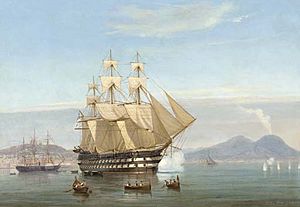HMS Exmouth (1854) facts for kids

Exmouth signalling her arrival at Naples
|
|
Quick facts for kids History |
|
|---|---|
| Name | HMS Exmouth |
| Ordered | 12 March 1840 |
| Builder |
|
| Laid down | 13 September 1841 |
| Launched | 12 July 1854 |
| Commissioned | 15 March 1855 |
| Out of service | Lent to Metropolitan Asylums Board as a training ship in 1877 |
| Fate | Sold for breaking up on 4 April 1905 |
| General characteristics | |
| Class and type | Albion-class ship of the line |
| Displacement | 4,382 tons |
| Tons burthen | 3,083 tons |
| Length | 243 ft (74 m) (overall) |
| Beam | 60 ft 2.5 in (18.352 m) |
| Depth of hold | 23 ft 8 in (7.21 m) |
| Propulsion |
|
| Sail plan | Full-rigged ship |
| Complement | 830 officers and men |
| Armament |
|
HMS Exmouth was a large and powerful warship of the Royal Navy. It was known as a "ship of the line" because it was big enough to fight in the main battle line of a fleet. This ship had 91 guns and could use both sails and a steam engine for power.
Building a Warship
The Exmouth was first ordered in 1841. It was planned to be a sailing ship with 90 guns. However, technology was changing quickly! In 1852, the Royal Navy decided to add a steam engine to the ship.
This big change meant the ship took longer to build. The work to add the steam engine began in 1853. Finally, the Exmouth was launched into the water on 12 July 1854. It was officially ready for service on 15 March 1855.
Life at Sea
In 1855, the Exmouth sailed in the Baltic Sea. This was during the final part of the Crimean War, a conflict involving several European powers. The ship served as the main ship, or "flagship," for Sir Michael Seymour, a high-ranking officer.
A couple of years later, in May 1857, the Exmouth accidentally ran aground near The Lizard in Cornwall. Luckily, the ship was refloated and no major damage occurred. After this, the ship's captain, Harry Ayres, was found responsible for the accident.
By 1859, the Exmouth was stationed at Devonport. It served as a "guard ship," helping to protect the port. A future admiral, Robert Spencer Robinson, was the captain of the Exmouth during this time.
A New Purpose
Later in its life, the Exmouth found a new and important role. In 1877, it was given to the Metropolitan Asylums Board. This organization used the ship as a training ship for young boys.
These training ships were a good way to help boys who were under the care of local authorities. It gave them a chance to learn skills and start a career, often in the navy or merchant shipping. This was seen as a way to help the boys and also benefit the country.
The Exmouth served as a training ship for many years. It was finally sold in 1905 and then taken apart.


